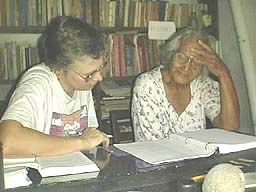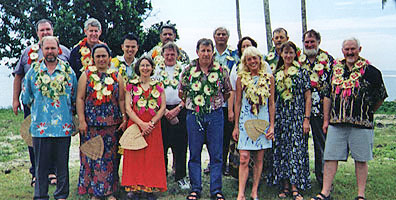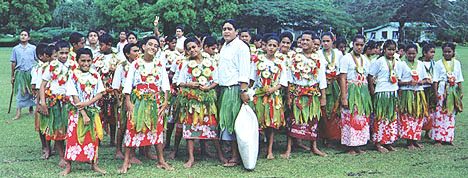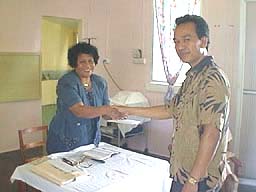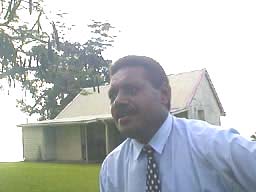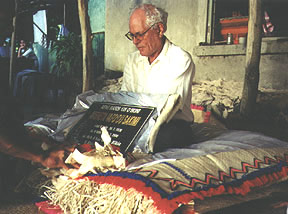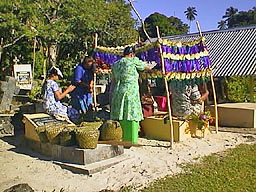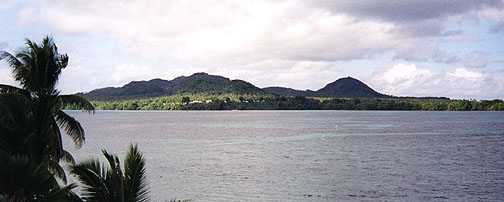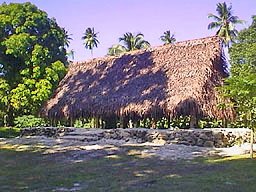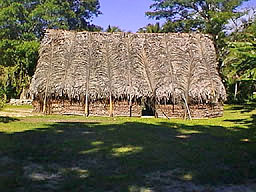Report of Visit to Rotuma, June 8-22, by Alan & Jan
We arrived on Rotuma on Friday 8 June (SunAir has switched its regular weekly flight to Rotuma from Saturdays to Fridays) and were greeted by Elisapeti Inia, among others. One of our main purposes in going to Rotuma was to finalize a draft of Elisapeti's forthcoming book on Rotuman ceremonies (to be published by Institute for Pacific Studies at University of the South Pacific, probably early next year; we have also obtained permission to post it on this website). Jan worked with Elisapeti every day editing the manuscript, finishing on the day before we left (22 June). Since we had no electricity we were unable to enter the changes into our computer until a neighbour with a generator (schoolmaster Vilsoni Frank) ran an extension cord from his house, up a coconut tree, across the road to another coconut tree, into Elisapeti's yard and through the front door. This allowed the work to carry on into the evenings. The weather was sultry at first, and on the night of 11-12 June was the most dramatic thunder and lightning storm we have ever experienced. It lasted for more than six hours and passed directly over Rotuma. Then the weather changed and we had a week of brilliant sunshine with cool breezes before the sultry weather and thunderstorms reappeared. On Wednesday 13 June Alan attended a kato'aga welcoming a group of Australians from the Wesley Mission in Sydney who came to Rotuma to build a library at Malhaha High School. The group was led by three Rotumans--Rejieli Flexman, Reverend Sydney Taito, and John Metusela. The other thirteen members of the group were Aussies who had volunteered to come to Rotuma to help build the library. The Mission raised A$75,000 and the Rotary Club in Sydney facilitated the collection and shipping of some 5,000 books, sent over last year. Construction of the library was held up for over a week because of shipping delays, but with the help of local Rotumans the crew managed to scrounge or borrow enough building materials to start the project anyway.
The mamasa for the Australians was followed by dance performances by the Malhaha school children. First the younger ones danced a spirited tautoga, followed by older groups of boys and girls performing dances resembling Tahitian tamure, Maori haka (a version of the Rotuman paddle dance), Samoan sitting dances, etc. There was a lot of clowning and, encouraged by Rejieli Flexman, considerable participation by the Australians, who poured powder, sprayed perfume, and danced comically, to the delight of the Rotuman audience.
We were told by the principal of Malhaha High School, Jione Tanu, that additional Australian aid (from government sources) is available for the construction of a computer laboratory, and one of the Australian visitors said he was optimistic that as many as 100 computers could be acquired for the schools in Rotuma. There is even some hope that Rotuma might soon be connected to the internet, despite current extremely high costs (one of twelve phone lines would have to be dedicated for internet access at a cost of some $1200 per month, we were told).
On Friday 15 June a contingent from the Tefui Club in Hawai'i (including Vilsoni Hereniko, Harieta Bennett, and ourselves) met with the Rotuma Hospital Board of Visitors. Hereniko, current president of the club, presented the Board with a check for F$3,055.45, the result of fund-raising activities in Hawai'i. The meeting was attended by the District Officer, Luke Moroivalu, and Chairman of the Rotuma Council, Visanti Makrava. Makrava explained to the Board why no doctor was assigned to Rotuma this year. He said that although the elder Dr Rafai, now retired, had volunteered to serve on Rotuma this year, the Council had passed a motion in 1997 that no retired doctors would be allowed to serve as chief medical officer on the island. On that authority the Chairman rejected Dr Rafai's offer. Makrava said that this was not a serious problem because Dr Taukave filled in when needed (unpaid) and that Nurse Practitioner Olovie was able to prescribe medication. Since all doctors have been assigned for the year Rotuma will not be able to recruit a Chief Medical Officer until January 2002. Makrava pointed out that seven districts in Fiji are on a waiting list, as there are not enough doctors to fill all the posts.
After the meeting we had an opportunity to talk with the D.O. at some length. He is a warm, friendly individual and seems to be getting on very well with the Council. He told us he was a "development person," with a degree in the sociology of development, but that he felt very frustrated because he was confronted with so many disputes he had little time for anything else. It seems people on Rotuma increasingly bring land disputes directly to the D.O. and make few attempts to solve them locally within the district. Moroivalu said that when he was D.O. in Ba he had far fewer disputes to settle although he had 60,000 people under his juristiction, whereas Rotuma has only around 2,500. One of the disputes he had to deal with just before we arrived concerned a dissident Austrian priest from New Zealand, who is no longer recognized by the mainstream Roman Catholic hierarchy. He came to minister to the Rotuman Catholics who have refused to accept the Church's change in usage from 'Atua to 'Aitu as the word for God. The group who cling to the 'Atua terminology requested that this priest be housed at Sumi Mission and be allowed to say mass in the church, but when the archbishop in Fiji was informed he instructed the resident priest, Father Milikiadi, not to allow him access to the mission station and church. On Sunday, when the 'Atua group went to the church, they were met by two policemen who refused to let them enter the church or to ring the bell. The dissident priest left the island a week after his arrival. On Saturday 16 June we participated in the höt'ak hafu for Akeneta Sakimi, which was held at Salosa, Lopo, in Itu'muta, home of Sakimi and Sarote Aprama and their children. Akeneta was like a sister to Alan, who had her headstone made in Fiji and sent to Rotuma. Alan held the stone on the päega and gave a speech about his debt to Akeneta and her family for taking him into their home for a whole year in 1959-60. It was a beautiful day and all of Itu'muta, and kainaga from elsewhere, honoured Akeneta with their presence.
On Sunday 17 June we accepted the invitation of Harieta Bennett to stay the night in Maftoa and enjoyed the fresh breezes and the view.
On the following day Itu'muta was having a taumaka for the upcoming Methodist Conference in Losa (15 July). This was their first practice but already we could tell it was going to be a smashing performance. Led by G/Tamanao, the Itu'muta gang is clearly a strong contender for first place. We enjoyed rehearsing with them and wish we could have stayed on as participants. Wednesday 20 June we went to Oinafa where we visited with G/Poar and Fanifau, Marseu and Mua Muaror, and Torika Mareta. Torika works at the new "Two Sisters" store in Noa'tau; it is located where the Raho store used to be. In the late afternoon we had a picnic on the beach at Oinafa hosted by Victor and Hanuarani Atalifo, with a kouaand barbecued lobster, chicken, and sausage, complimented by yam "potato" salad! It was great to have yet another chance to swim in that lovely, picturesque bay. We had several opportunities to visit with Vilsoni Hereniko and his wife, Jeannette, at Mea, Hapmak. They were preparing the set for the feature movie they are producing, entitled Fire in the Womb (see newspaper account). The set was just about finished and they were awaiting the arrival of the film crew (who came on the plane just when we left). Everyone on Rotuma is excited about the film which will be mostly in Rotuma (with English subtitles) and with mostly Rotuman actors. Rena Owen, the renowned Maori actress who starred in Once Were Warriors, plays the legendary character of Hanitema'us. Vili was still casting roles when we left, but major roles will be played by Dr John Fatiaki and Maniue Vilsoni (who has been given two weeks leave from Marist High School in order to act in the film). Elisapeti Inia will play the role of han mane'ak su in an important wedding scene.
In Suva we had the privilege of addressing the Rotuman students at Marist High School--all 96 of them. Our message to the students: Rotuman culture is a precious asset that should be cherished, especially the key values that provide its foundation, summed up in the deeper meaning of the words hanisi, garue, and faiaksea. Our talk was enhanced by a photo display by François Deschamps, a professor at New York University-New Paltz, who has visited Rotuma twice and has held several exhibitions of his Rotuman photography in the U.S. François was on his way to Rotuma where he will take pictures to illustrate the cover of Elisapeti's book on Rotuman ceremonies. Random memories from Rotuma: fava trees
loaded with ripening fruit...fanning away the flies at mealtime...mosquitoes
buzzing in our ears...the secure feeling of sleeping under a mosquito
net, safe from the insects that inhabited our bedroom during the night...going
to bed at 7:30 p.m. because we had no electricity and no good lights...the
crowing of roosters at all times of the day and night...finally getting
Elisapeti's kerosene refrigerator to work with the wicks we bought
over the internet (they're no longer available in Fiji)...
The night sky in all its glory...the Southern Cross and Milky Way, made so much more visible by the absence of electric lights...the brightness of white sand in moonglow...the sheen that the moon's light gave to the leaves of coconut trees...Our early morning walks, during which we met men carrying baskets of coconuts to feed the pigs, people calling chickens to feed...the smell of smoke from kohea...the morning star bright in the sky at dawn...schoolchildren in their uniforms waiting for the bus...old women bent over at the waist like animated jackknives, sweeping leaves...vea (mudhens) darting across the road...cold water showers, ever so refreshing after hot walks and sweating profusely...the water being shut off in afternoons and nights & bathing with a dipper from a bucket...The heat of the sun at midday, and how delicious a cool breeze feels when it comes...young boys carrying big bundles of leaves on their heads...little girls carrying even littler ones in their arms...the intense blue of the sea, set off by the foamy white breakers on the fringing reef...the lush vegetation--so many shades of green--topped by majestic coconut palms loaded with nuts...watching the brilliant red and black armea sucking honey from the blossoms of pandanus plants (hata) across the road from Elisapeti's house...The food...a'ana, papai, fekei...so many kinds of bananas...'esu (papaya) for breakfast every day...vati...the toughest chickens in the world...poat kau, fresh fish...watching people mif the flesh off the bones of tiny fish...The buildings...the Catholic churches at Sumi and Upu...the new Methodist Church at Savlei...the school buildings at Malhaha...unfinished two-story houses, unpainted, with walls of grey concrete...the Post Office Shop, the hospital, and the other buildings at the government station in Ahau...derelict, roofless houses long ago abandoned... Waiting for the boat (Bula ne Ceva) that was supposed to arrive on Thursday...delayed to Saturday...delayed to Tuesday...delayed again to Thursday...delayed till whenever... |
||||||||||||||||||||||
